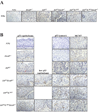E6-associated protein is required for human papillomavirus type 16 E6 to cause cervical cancer in mice
- PMID: 20530688
- PMCID: PMC2888794
- DOI: 10.1158/0008-5472.CAN-09-3307
E6-associated protein is required for human papillomavirus type 16 E6 to cause cervical cancer in mice
Abstract
High-risk human papillomaviruses (HPV) cause certain anogenital and head and neck cancers. E6, one of three potent HPV oncogenes that contribute to the development of these malignancies, is a multifunctional protein with many biochemical activities. Among these activities are its ability to bind and inactivate the cellular tumor suppressor p53, induce expression of telomerase, and bind to various other proteins, including Bak, E6BP1, and E6TP1, and proteins that contain PDZ domains, such as hScrib and hDlg. Many of these activities are thought to contribute to the role of E6 in carcinogenesis. The interaction of E6 with many of these cellular proteins, including p53, leads to their destabilization. This property is mediated at least in part through the ability of E6 to recruit the ubiquitin ligase E6-associated protein (E6AP) into complexes with these cellular proteins, resulting in their ubiquitin-mediated degradation by the proteasome. In this study, we address the requirement for E6AP in mediating acute and oncogenic phenotypes of E6, including induction of epithelial hyperplasia, abrogation of DNA damage response, and induction of cervical cancer. Loss of E6AP had no discernible effect on the ability of E6 to induce hyperplasia or abrogate DNA damage responses, akin to what we had earlier observed in the mouse epidermis. Nevertheless, in cervical carcinogenesis studies, there was a complete loss of the oncogenic potential of E6 in mice nulligenic for E6AP. Thus, E6AP is absolutely required for E6 to cause cervical cancer.
Figures



References
-
- Walboomers JM, Jacobs MV, Manos MM, et al. Human papillomavirus is a necessary cause of invasive cervical cancer worldwide. J Pathol. 1999;189:12–19. - PubMed
-
- zur Hausen H. Papillomavirus infections--a major cause of human cancers. Biochim Biophys Acta. 1996;1288:F55–F78. - PubMed
-
- Parkin DM. The global health burden of infection-associated cancers in the year 2002. Int J Cancer. 2006;118:3030–3044. - PubMed
-
- Parkin DM, Bray F. Chapter 2: The burden of HPV-related cancers. Vaccine. 2006;24 Suppl 3 S3/11–25. - PubMed
-
- Sankaranarayanan R, Ferlay J. Worldwide burden of gynaecological cancer: the size of the problem. Best Pract Res Clin Obstet Gynaecol. 2006;20:207–225. - PubMed
Publication types
MeSH terms
Substances
Grants and funding
LinkOut - more resources
Full Text Sources
Medical
Molecular Biology Databases
Research Materials
Miscellaneous

